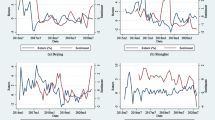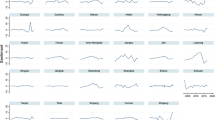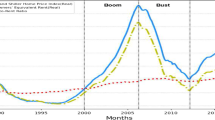Abstract
We investigate the impact of sentimental shocks on house price fluctuations in the Euro area. To this end, we isolate and measure non-fundamental-based sentimental shocks by employing survey-based indicators that proxy four key types of expectations of housing market participants. The novelty of our study is that specific sentimental shocks are identified through four uncertainty transmission channels in the real estate market (i.e., the precautionary savings channel, the credit supply channel, the credit demand, and the inflationary channel). We provide strong evidence that sentimental shocks drive fluctuations in house prices even in the absence of any changes in aggregate fundamentals. Finally, we find that these results are more pronounced in the peripheral Euro area countries. The finding that the real estate market is also governed by irrational behavior implies that both governments and policymakers should consider sentimental shocks when they form their real estate market policies or take actions to stabilize and improve the proper function of the European housing market.



Similar content being viewed by others
Data Availability
The data are not publicly acailable for ethical reasons. However, they can be provided upon request from the corresponding author.
Code Availability
The analysis was conducted using the Eviews 11 software.
Notes
According to Clayton et al. (2009), the behavioral approach explicitly recognizes that some investors are not rational and that systematic biases in these investor’s beliefs induce them to trade on non-fundamental information (i.e., sentiment).
This is also in line with Gerlach and Peng (2005) who stated that credit conditions affect asset valuations, as decreases in credit availability may shrink the demand for a fixed supply of properties.
A deterioration of expectations could be for example the outcome of either a very high leverage or an adverse change in the risk-free rate as well as in the loan recovery rate which, as indicated by Geanakoplos (2010) and empirically confirmed by Wang and Zhang (2014) could trigger a financial crisis.
Banti and Phylaktis (2019) find that liquidity shocks have a significant impact on house prices in both emerging and advanced economies, signifying the high exposure of housing markets around the world to liquidity conditions.
In general, an asset class can be considered as safe-haven when its value increases while the reference portfolio of risky assets is losing value during risky times (Baur & Lucey, 2010; Eraslan, 2016). Traditionally, gold (Baur & Lucey, 2010; Baur & McDermott, 2016; Dicle & Levendis, 2017) and foreign exchange currencies (Grisse & Nitschka, 2015) are considered as safe-haven assets in the literature, especially during periods of financial turmoil.
The sample of countries and time span were selected based on data availability.
The diffusion index for credit standards is defined as the difference between the weighted sum of the percentages of banks responding, “tightened considerably” and “tightened somewhat”, and the weighted sum of the percentages of banks responding “eased considerably” and “eased somewhat”. Regarding demand for loans, the diffusion index is defined as the difference between the weighted sum of the percentages of banks responding, “increased considerably” and “increased somewhat”, and the weighted sum of the percentages of banks responding “decreased considerably” and “decreased somewhat”. (Bank lending survey for the Euro area—Glossary, p. 4). Thus, a relatively high diffusion index suggests that we have an economy with more tighten bank credit standards (i.e., less loan supply) and/or greater willingness for loan demand, respectively.
The reason why we model the relation between sentiment and house prices employing a lag structure model is twofold. First, because we want to mitigate any possible endogeneity issues, and second to recognize the nature of housing data. Since a sale transaction can take 30–90 days, or more, to be completed, actual price movements in a quarter may also be reflected in the next quarter’s statistics (Ling et al., 2015). Therefore, any price effects should be felt in the next quarter rather than the concurrent quarter.
The classic approach of Difference-GMM, firstly proposed by Arellano and Bond (1991) was not preferred because according to the literature it suffers from poor accuracy in simulation and from significant finite-sample bias.
According to Wintoki et al. (2012), in panel data, System GMM provides more consistent results in the presence of different sources of endogeneity.
According to Duca et al. (2010), a tightening of credit standards enables less population to buy homes, thus reducing the flow of demand for housing.
The imain imerit iof ithe iPCA iis ithat iit iaggregates ithe ialready iexisting iinformation of ithe ithree idifferent iindividual isurvey-based isentiment imeasures iinto ia isingle isentiment iindicator. iThis ielicited ifirst iprincipal icomponent igives ia isense iof ithe idimensionality iof ithe ithree iindividual isentiment iindices.
References
Abildgren, K., Hansen, N. L., & Kuchler, A. (2018). Overoptimism and house price bubbles. Journal of Macroeconomics, 56, 1–14.
Adams, Z., & Füss, R. (2010). Macroeconomic determinants of international housing markets. Journal of Housing Economics, 19(1), 38–50.
Anari, A., & Kolari, J. (2002). House prices and inflation. Real Estate Economics, 30(1), 67–84.
Anastasiou, D., and Katsafados, A. G. (2020). Bank Deposits Flows and Textual Sentiment: When an ECB President's speech is not just a speech. MPRA WP, No. 99729.
Anastasiou, D., & Drakos, K. (2021). European depositors’ behavior and crisis sentiment. Journal of Economic Behavior & Organization, 184, 117–136.
Anastasiou, D., and Kapopoulos, P. (2021). Dynamic linkages among financial stability, house prices and residential investment in Greece. MPRA WP, No. 107833.
Anastasiou, D., Louri, H., & Tsionas, M. (2019). Non-Performing Loan in the Euro-area: Are Core-Periphery Banking Markets Fragmented? International Journal of Finance and Economics, 24(1), 97–112.
Anastasiou, D., Ballis, A., and Drakos, K. (2021). Cryptocurrencies’ Price Crash Risk and Crisis Sentiment. Finance Research Letters, 101928.
Andrés, J., & Hernando, I. (2007). Does Inflation Harm Economic Growth? Evidence from the OECD, Ch. University of Chicago Press, 8, 315–348.
Angeletos, G. M., & La’O, J. (2013). Sentiments. Econometrica, 81(2), 739–779.
Arellano, M., & Bond, S. (1991). Some tests of specification for panel data: Monte Carlo evidence and an application to employment equations. The Review of Economic Studies, 58(2), 277–297.
Baffoe-Bonnie, J. (1998). The dynamic impact of macroeconomic aggregates on housing prices and stock of houses: A national and regional analysis. The Journal of Real Estate Finance and Economics, 17(2), 179–197.
Baker, M., & Wurgler, J. (2007). Investor Sentiment in the Stock Market. Journal of Economic Perspectives, 21, 129–151.
Banti, C., & Phylaktis, K. (2019). Global liquidity, house prices and policy responses. Journal of Financial Stability, 43, 79–96.
Baur, D. G., & Lucey, B. M. (2010). Is gold a hedge or a safe haven? An analysis of stocks, bonds and gold. Financial Review, 45(2), 217–229.
Baur, D. G., & McDermott, T. K. (2016). Why is gold a safe-haven? Journal of Behavioral and Experimental Finance, 10, 63–71.
Beltratti, A., & Morana, C. (2010). International house prices and macroeconomic fluctuations. Journal of Banking and Finance, 34(3), 533–545.
Benjamin, J., Chinloy, P., & Jud, D. (2004). Why do households concentrate their wealth in housing? Journal of Real Estate Research, 26(4), 329–344.
Bijsterbosch, Μ, & Falagiarda, Μ. (2015). The macroeconomic impact of financial fragmentation in the Euro Area: Which role for credit supply? Journal of International Money and Finance, 54, 93–115.
Blundell, R., & Bond, S. R. (1998). Initial conditions and moment restrictions in dynamic panel data models. Journal of Econometrics, 87(1), 115–143.
Bovi, M. (2009). Economic versus psychological forecasting. Evidence from consumer confidence surveys. Journal of Economic Psychology, 30(4), 563–574.
Caglayan, M., & Xu, B. (2016). Sentiment volatility and bank lending behavior. International Review of Financial Analysis, 45, 107–120.
Clayton, J., Ling, D. C., & Naranjo, A. (2009). Commercial real estate valuation: Fundamentals versus investor sentiment. The Journal of Real Estate Finance and Economics, 38(1), 5–37.
Cox, J., and Ludvigson, S. C. (2019). Drivers of the great housing boom‐bust: Credit conditions, beliefs, or both? Real Estate Economics, 1–33.
Da, Z., Engelberg, J., & Gao, P. (2015). The sum of all FEARS: Investor sentiment and asset prices. The Review of Financial Studies, 28(1), 1–32.
Damianov, D. S., Wang, X., and Yan, C. (2020). Google Search Queries, Foreclosures, and House Prices. The Journal of Real Estate Finance and Economics, 1–33.
Das, P., Füss, R., Hanle, B., and Russ, I. N. (2020). The cross-over effect of irrational sentiments in housing, commercial property, and stock markets. Journal of Banking and Finance, 105799.
Demirguc-Kunt, A., Detragiache, E., & Merrouche, O. (2013). Bank Capital: Lessons from the Financial Crisis. Journal of Money, Credit and Banking, 45, 1147–1164.
Dicle, M. F., & Levendis, J. (2017). Hedging market volatility with gold. Quantitative Finance and Economics, 1(3), 253–271.
Dossche, M., and Zlatanos, S. (2020). COVID-19 and the increase in household savings: precautionary or forced? Economic Bulletin Boxes, 6, ECB.
Duca, J. V., Muellbauer, J., & Murphy, A. (2010). Housing markets and the financial crisis of 2007–2009: Lessons for the future. Journal of Financial Stability, 6(4), 203–217.
Égert, B., & Mihaljek, D. (2007). Determinants of house prices in central and eastern Europe. Comparative Economic Studies, 49(3), 367–388.
Engelhardt, G. V., & Mayer, C. J. (1998). Intergenerational Transfers, Borrowing Constraints, and Saving Behavior: Evidence from the Housing Market. Journal of Urban Economics, 44, 135–157.
Eraslan, S. (2016). Safe-haven demand for housing in London. Economic Modelling, 58, 482–493.
Galariotis, E. C., Makrichoriti, P., & Spyrou, S. (2016). Sovereign CDS spread determinants and spill-over effects during financial crisis: A panel VAR approach. Journal of Financial Stability, 26, 62–77.
Gan, J. (2010). Housing wealth and consumption growth: Evidence from a large panel of households. The Review of Financial Studies, 23(6), 2229–2267.
Geanakoplos, J. (2010). The leverage cycle. In D. Acemoglu, K. Rogoff, & M. Woodford (Eds.), NBER Macroeconomic Annual 2009, 24 (pp. 1–65). University of Chicago Press.
Gerlach, S., & Peng, W. (2005). Bank lending and property prices in Hong Kong. Journal of Banking and Finance, 29(2), 461–481.
Gerlach-Kristen, P., and McInerney, N. (2014). The role of credit in the housing market. ESRI Working Paper, No. 495, Dublin.
Gibson, H. D., Hall, S. G., & Tavlas, G. S. (2016). How the euro-area sovereign-debt crisis led to a collapse in bank equity prices. Journal of Financial Stability, 26, 266–275.
Gimeno, R., & Martinez-Carrascal, C. (2010). The relationship between house prices and house purchase loans: The Spanish case. Journal of Banking and Finance, 34(8), 1849–1855.
Glaeser, E., Gyourko, J., Morales, E., & Nathanson, C. (2014). Housing Dynamics: An Urban Approach. Journal of Urban Economics, 81, 45–56.
Gómez-Puig, M., Sosvilla-Rivero, S., & del Carmen Ramos-Herrera, M. (2014). An update on EMU sovereign yield spread drivers in times of crisis: A panel data analysis. The North American Journal of Economics and Finance, 30, 133–153.
González-Fernández, M., & González-Velasco, C. (2020). A sentiment index to measure sovereign risk using Google data. International Review of Economics & Finance, 69, 406–418.
Granziera, E., & Kozicki, S. (2015). House price dynamics: Fundamentals and expectations. Journal of Economic Dynamics and Control, 60, 152–165.
Grisse, C., & Nitschka, T. (2015). On financial risk and the safe haven characteristics of Swiss franc exchange rates. Journal of Empirical Finance, 32, 153–164.
Ioannides, Y. M. (1989). Housing, Other Real Estate, and Wealth Portfolios: An Empirical Investigation Based on the 1983 Survey of Consumer Finances. Regional Science and Urban Economics, 19, 259–280.
Ivashina, V., & Scharfstein, D. (2010). Bank lending during the financial crisis of 2008. Journal of Financial Economics, 97, 319–338.
Kapopoulos, P., Zekente, K., and Rizos, A. (2020). The rise, fall and revival of the residential property market in Greece: Bringing new drivers of house price fluctuations to the foreground. Insights, 1, 1–20, Alpha Bank.
Katrakilidis, C., & Trachanas, E. (2012). What drives housing price dynamics in Greece: New evidence from asymmetric ARDL cointegration. Economic Modelling, 29(4), 1064–1069.
Koetter, M., & Poghosyan, T. (2010). Real estate prices and bank stability. Journal of Banking and Finance, 34(6), 1129–1138.
Kopyl, K. A., & Lee, J. B. T. (2016). How safe are the safe haven assets? Financial Markets and Portfolio Management, 30(4), 453–482.
Kraft, H., & Munk, C. (2011). Optimal housing, consumption, and investment decisions over the life cycle. Management Science, 57(6), 1025–1041.
Lagerborg, A., Pappa, E., and Ravn, M. O. (2020). Sentimental business cycles. Working Paper.
Lambertini, L., Mendicino, C., & Punzi, M. T. (2013). Expectation-driven cycles in the housing market: Evidence from survey data. Journal of Financial Stability, 9(4), 518–529.
Lane, P. R. (2012). The European sovereign debt crisis. Journal of Economic Perspectives, 26, 49–68.
Ling, D. C., Ooi, J. T., & Le, T. T. (2015). Explaining house price dynamics: Isolating the role of nonfundamentals. Journal of Money, Credit and Banking, 47(S1), 87–125.
Ludvigson, S. C. (2004). Consumer confidence and consumer spending. Journal of Economic Perspectives, 18(2), 29–50.
Milani, F. (2017). Sentiment and the U.S. business cycle. Journal of Economic Dynamics and Control, 82, 289–311.
Mishra, A. K., Uematsu, H., & Powell, R. R. (2012). Precautionary wealth and income uncertainty: A household-level analysis. Journal of Applied Economics, 15(2), 353–369.
Mody, A., Ohnsorge, F., & Sandri, D. (2012). Precautionary savings in the great recession. IMF Economic Review, 60(1), 114–138.
Moore, A. (2017). Measuring economic uncertainty and its effects. Economic Record, 93(303), 550–575.
Musso, A., Neri, S., & Stracca, L. (2011). Housing, consumption and monetary policy: How different are the US and the euro area? Journal of Banking and Finance, 35(11), 3019–3041.
Nowak, A. D., Price, B. S., and Smith, P. S. (2019). Real Estate Dictionaries Across Space and Time. The Journal of Real Estate Finance and Economics, 1–25.
Ortalo-Magne, F., & Rady, S. (2006). Housing market dynamics: On the contribution of income shocks and credit constraints. The Review of Economic Studies, 73(2), 459–485.
Piazzesi, M., & Schneider, M. (2009). Momentum traders in the housing market: Survey evidence and a search model. American Economic Review, 99(2), 406–411.
Piazzesi, M., & Schneider, M. (2016). Housing and Macroeconomics. Handbook of Macroeconomics, 2(Chapter 19), 1547–1640.
Scherbina, A., & Schlusche, B. (2014). Asset price bubbles: A survey. Quantitative Finance, 14(4), 589–604.
Schwartz, A. J. (1998). Why financial stability depends on price stability. In Money, prices and the real economy (Vol. 34, p. 41). Edward Elgar.
Shiller, R. J. (2009). Animal spirits. Princeton University Press.
Soo, C. K. (2018). Quantifying sentiment with news media across local housing markets. The Review of Financial Studies, 31(10), 3689–3719.
Tsatsaronis, K., and Zhu, H. (2004). What drives housing price dynamics: cross-country evidence. BIS Quarterly Review.
Wang, F. A., & Zhang, T. (2014). Financial crisis and credit crunch in the housing market. The Journal of Real Estate Finance and Economics, 49(2), 256–276.
Wintoki, M. B., Linck, J. S., & Netter, J. M. (2012). Endogeneity and the dynamics of internal corporate governance. Journal of Financial Economics, 105(3), 581–606.
Acknowledgements
First and foremost, we would like to thank the Editor (James B. Kau) and the two anonymous referees for their constructive recommendations that vastly enhanced a previous version of this manuscript. We would also like to thank our colleagues from Alpha Bank Economic Research (especially Anastasios Rizos), Athens University of Economics and Business, the ECB, and Aston University. Any remaining errors are the responsibility of the authors.
Author information
Authors and Affiliations
Contributions
Not applicable.
Corresponding author
Ethics declarations
Disclaimer
The views and opinions expressed in this paper are those of the authors and do not necessarily reflect those of their respective institutions.
Conflicts of Interest
The authors declare that they have no known competing financial interests or personal relationships that could have appeared to influence the work reported in this paper.
Additional information
Publisher’s Note
Springer Nature remains neutral with regard to jurisdictional claims in published maps and institutional affiliations.
Appendix
Appendix
Rights and permissions
About this article
Cite this article
Anastasiou, D., Kapopoulos, P. & Zekente, KM. Sentimental Shocks and House Prices. J Real Estate Finan Econ 67, 627–655 (2023). https://doi.org/10.1007/s11146-021-09871-z
Accepted:
Published:
Issue Date:
DOI: https://doi.org/10.1007/s11146-021-09871-z
Keywords
- House Prices
- Real Estate Market
- Sentimental Shocks
- Macroeconomic Fundamentals
- Uncertainty Transmission Channels




